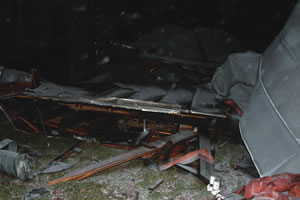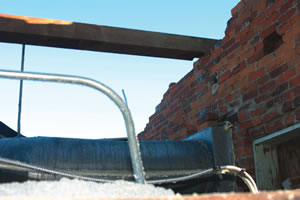
Morgan Circuit Clerk Peggy Mayfield had just stopped by her office to pick up the mail and check her email around 7:30 p.m. on the evening of January 29th, when a savage storm lashed its way through Martinsville.
As the wind gathered strength, the lights in the 1859 Courthouse flickered and then went out. Crouching beside her desk, she feared the windows in her office were about to blow out. Then she heard something she had never heard before.
“It was like the sound Godzilla makes when it’s tearing and twisting metal. That’s the only way I can describe it,” Mayfield recalled.
What she heard was a large part of the metal roof of the Courthouse being peeled off like the pop-top lid of a tuna can. It slid down the side of the Courthouse and deposited itself in a tangled heap on the lawn. In its wake, it left 149-year old handmade square nails scattered throughout the square, recalled Judge Christopher Burnham.
Until the storm passed, the rain drove down onto the building’s ancient timbers, some of which had not been exposed to the sky since Abraham Lincoln was campaigning for President. Water from the open roof drained into the Courthouse, damaging the courtroom ceiling and threatening the evidence room of Judge Jane Spencer Craney’s Superior Court III.
Wet insulation was strewn throughout the Courthouse. With the heat off, the Courthouse grew cold as Morgan County mounted its rescue and reconstruction effort. The county’s local insurance agent was on hand almost immediately and a representative from the insurance company was on site within an hour.
“One of the benefits of a small town,” noted Judge Thomas Gray, who said the local hardware store provided tarps to keep the rain off furniture and documents. Less than two hours after the storm had passed, my cell phone rang.
It was Judge Gray, requesting that the Supreme Court invoke the newly effective Administrative Rule 17. Ironically, Judge Gray is probably only one of a handful of trial judges in Indiana who are even aware of Rule 17 and its ability to allow courts to operate in the event of a disaster, natural or otherwise.
After Hurricane Katrina, the Supreme Court and the Indiana Judicial Conference began a concerted effort to prepare for disasters. The Judicial Administration Committee, led by Howard Circuit Court Judge Lynn Murray, began developing a template for Continuity of Operations Plans (COOP) for Indiana’s trial courts. One of their tasks was to draft Administrative Rule 17 to codify the Supreme Court’s inherent power to oversee the administration of trial courts in the event of a disaster.
A key concern when there is a disruption of normal court operations is the tolling of time limits and statutes of limitations. Administrative Rule 17 allows a local trial court to petition the Supreme Court to “stop the clock” on “time limits currently imposed for speedy trials in criminal and juvenile proceedings, public health, mental health, appellate, and all other civil and criminal matters.”
Rule 17 had been approved on September 10, 2007, but was not effective until January 1, 2008. Morgan County Judges were the first to invoke it.

On the morning after the storm, as debris from the roof and tree limbs were being removed from the Courthouse lawn, I met in Judge Burnham’s chilly first-floor courtroom with three of the four Morgan County Judges, Clerk Marguerite Mayfield, and Robert Hagee of the Prosecutor’s Office.
We gathered details of what the judges needed and placed a phone call to State Court Administration Executive Director, Lilia Judson. She drafted the Morgan County courts’ petition for relief under Rule 17 and also prepared for signature the Supreme Court’s order of approval.
The Morgan County judges asked the Supreme Court to toll all of the time limits contemplated by the rule, to allow for the closure of the courts and clerk’s office from January 30th until February 11th, to move court operations out of the courthouse, and to allow each of the judges to exercise general jurisdiction over each of their cases. The order was faxed to Judge Burnham’s court, which was one of the few still operating in the Courthouse. The nearby law offices of Foley, Foley & Peden had also offered the use of their fax as a backup. Since the judges had already determined that Judge Gray could issue orders on their behalf in the event of an emergency, he signed it and sent it to Indianapolis to be filed with the Clerk of the Supreme Court. Justice Theodore Boehm signed the Supreme Court’s order as Acting Chief Justice.
The Courthouse re-opened to the public a week earlier than requested on February 4th, but there were quite a few adjustments.
To continue operations, Judge Craney moved her second-floor court, and the entire contents of the court’s evidence room, to the Lucille Sadler Room in the County’s nearby Administration Building. Her courtroom will have to undergo extensive repairs and may be unavailable for many more weeks. Judge Gray will also occasionally conduct courtroom business in the Martinsville City Court. Judge Burnham is staying put, as his first floor courtroom escaped all but slight damage. Circuit Judge Pro Tem Brian Williams is conducting business as usual, as is the Prosecutor, and the Clerk.
In the meantime, as contractors begin to repair and replace the Courthouse roof, State Court Administration and the Indiana Judicial Conference continue to enhance disaster-planning efforts for the trial courts and the people they serve. Morgan County courts served as a great test case for the implementation of Administrative Rule 17. Although it is our guess that they would have gladly allowed another county to have had the privilege.